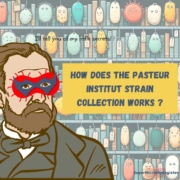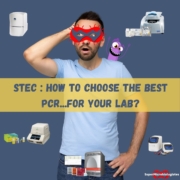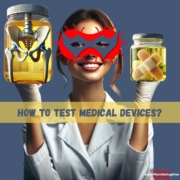Microbiology Pharma: How to choose the best RMM for your QC lab?
Rapid methods (or alternative methods) in microbiology laboratories are somewhat of an elusive concept. Despite years of discussion, their routine application remains sparse.
Yet, theoretically, the benefits of rapid methods are significant (time savings, accuracy, automation, etc.).
So, why the slow adoption?
Implementing a rapid method is not just a task for the microbiology lab. It’s a comprehensive and strategic project for the company, requiring appropriate resources and management.
To ensure success in your “rapid method” project, this article will address key considerations before embarking on this significant endeavor!
Contents:
- What is a rapid method in microbiology?
- Pre-requisites for adopting a RMM
- Selecting the best RMM for your lab
- Consulting with other users
Best RMM
Discover what are the 7 best Pharma RMM
We surveyed the SuperMicrobiologists,
here are the highest-rated RMMs.
What is a rapid method in microbiology?
A rapid microbiology method is an alternative approach that provides results faster than traditional methods. Depending on the test and technology, it can save a few hours to several days.

RMMs must be validated following the European Pharmacopoeia chapter 5.1.6 (Alternative methods for microbiological quality control) and/or USP <1223> (Validation of alternative microbiological methods) and/or PDA Technical report No. 33 (Evaluation, Validation, and Implementation of Alternative and Rapid Microbiological Methods).
Validation often presents the most significant challenge.
Pre-requisites for adopting a rapid microbiology method
Diving headfirst into purchasing a rapid method just because the QA manager saw a “great new tech” at an PDA Micro booth is unwise. Here’s how to properly prepare for the introduction of new technology:
A rapid method for which analysis?
It’s unrealistic to expect rapid technology to replace all existing tests. It’s better to focus on a test where time savings are strategically beneficial.
Sterility testing is an obvious choice… the idea of saving 14 days is appealing. However, due to validation constraints, both internal and regulatory, few technologies are used in routine to replace sterility tests.
There might be other tests, easier to validate, where a rapid method could be beneficial. These include:
- Environmental controls.
- Raw material load tests.
- Rinse waters.
- Validation of new water loops.
- Recommissioning of loops.
- Rinse protocols.
- etc.
While less glamorous than sterility testing, these can significantly benefit the lab and company.
Identifying tests helps determine performance objectives:
- Qualitative or quantitative test
- Detection or quantification limit (LOD, LOQ)
- Sensitivity
- Specificity
- Target microorganisms (bacteria, yeast, mold)
Involving the lab and other departments
Implementing a rapid method will change the microbiology laboratory’s life and also affect other departments’ routines:
- Quality assurance (e.g., receiving microbiology results before chemistry!).
- Production (e.g., faster production launch after cleaning).
- Logistics (e.g., reduced stock, faster delivery to the final customer).
- Finance (e.g., likely a higher lab budget, but reduced product losses)
There are as many examples as there are organizations. It’s your job to convince all these services of the benefits of adopting this new technology. Otherwise, expect obstacles!
For the microbiology lab, changing routines is never easy. Additionally, the benefits of using a rapid method are rarely felt at the lab level. Thus, fully engaging the lab in the project is crucial, but we’ll refrain from giving specific advice here.
Planning a validation team
Conducting validation while managing routine microbiological QC is challenging. Ideally, a dedicated validation team should be formed, preferably including microbiologists with routine experience!
Writing a specification document
This step is often skipped, yet it’s vital. We won’t detail your expectations here, but broadly describe what you expect from the technology:
- Save at least x hours or days.
- Compatible with x% of your matrices.
- Expected performance level (detection or quantification limit, accuracy, etc.).
- Maximum cost per test x€.
- Need for post-analysis identification (destructive method or not).
- etc.
You can also describe more “subjective” expectations like ease of use, technology automation, LIMS connectivity.
After completing this step (and the previous ones), you’re ready to meet with rapid method providers.
Selecting the best rapid method for your lab
All technologies on the market are “good,” but they may not be suitable for your lab. It’s up to you to find the RIGHT one!
Performances
To do this, present your specification document to the provider to see if their technology can achieve the performance you expect (LOD, LOQ, sensitivity, specificity, time to result (TTR), etc.).
Matrix compatibility
Have your matrices been tested with the technology? If not, the provider should conduct a feasibility study. You’ve already determined your priority matrices at the previous step, so now they need to be tested.
Paid or free feasibility study?
Feasibility studies are work-intensive, so some providers may charge for them (around €1000 per matrix depending on the study’s complexity). This also helps the provider gauge the lab’s genuine interest in the technology.
Ease of use
This is subjective, but generally, the fewer the manipulation steps, the easier the technology is to use.
The easier a technology is to use, the less likely errors are, making the results more reproducible and robust.
For this, request a live demonstration of the technology and, if possible, a trial period in the laboratory.
Ease of result interpretation
Does the technology provide a clear answer without microbiologist intervention? If the microbiologist must decide, is it easy to make that decision?
Depending on the test type, the microbiologist’s decision can be crucial (e.g., a sterility test on an injectable product with suspected contamination).
Training
How will training be conducted, how long will it last, and how many people can participate?
Reagents and consumables
Often, providers offer “captive” rapid methods. That is, they supply both the technology and the reagents, and without these reagents, the technology cannot be used.
If so, consider the following:
What happens if there’s a supply disruption or if the provider goes out of business (check the company’s financial health)?
A complete audit of the provider might be necessary.
Using a “captive” technology can also be an advantage.
If the provider’s business model is based on selling reagents, you can likely count on their support to validate the technology and quickly transition to routine use… to consume more reagents!
Price
To justify the investment to accounting, you’ll need to discuss costs:
- Technology
- Reagents and consumables (cost per test)
- Validation documents (IQ, OQ, PQ)
- Possibly, training for validation
- Maintenance contracts
Validation
Validation is the project’s most critical step. The more the provider can assist in this stage, the faster and more likely the technology will transition to routine use.
Can they provide IQ (Installation Qualification), OQ (Operational Qualification), and PQ (Performance Qualification) documents?
Do they offer services for conducting IQ and OQ? IQ-OQ validation typically takes 1 to 5 days (depending on the technology).
For PQ, is specific training available? Is organized follow-up possible? PQ can take several weeks or months, so the provider’s support is crucial for successful validation.
Have other laboratories already validated this technology for the same test type as ours?
After-sales service
What happens if the technology fails? Standard exchange or onsite repair? How many days will it take? If the machine is replaced, what about re-validation (IQ, OQ)?
What do maintenance contracts cover? What is the MTBF (Mean Time Between Failures) of the technology?
Consulting with other users
Choosing a rapid method is a significant decision for the company. Leave nothing to chance.
Ideally, before committing, take time to discuss and meet with several technology users.
If possible, avoid contacts provided by the provider. You can find other users at a conference, on LinkedIn, by reactivating an old classmate, or by asking SuperMicrobiologists!
Once in contact, discuss:
- Technology performance (are the advertised performances the same as those achieved?).
- Technology reliability.
- Validation (how long, with how many people, acceptance by authorities).
- The technology’s “disadvantages” and limitations. Providers rarely communicate about this, yet all technologies have limitations. Knowing these limits allows you to not exceed them!
Trust in the supplier
The last argument, which applies to all technologies, is… the trust you have in your provider!
This may seem subjective, but it can be based on tangible criteria, such as:
- Is it easy to reach them by phone? Do you directly connect with them or a voice server?
- Have you previously worked with them? If not, it might be worth inquiring with another lab (on LinkedIn or via SuperMicrobiologistes).
- Are they responsive and quick to provide solutions in case of problems?
You now have all the information needed to choose the perfect rapid method for your lab. It’s your move!

















Leave a Reply
Want to join the discussion?Feel free to contribute!